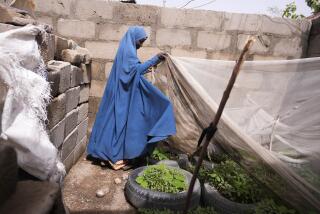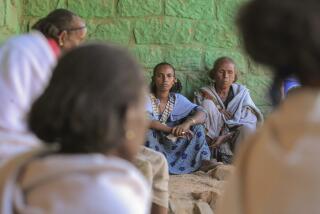Vietnam’s Population Growth Outstrips Food Production
- Share via
BANGKOK, Thailand — Hard hit by shortages across the board, Vietnam suffers most in the area that is critical for many underdeveloped countries--a lack of food.
Three years of stalled crop production have reduced the amount of food per capita by 8% since 1985. There is little money in the treasury to buy food abroad, and in a sort of Catch-22, the country’s prime prospect for building financial reserves is exporting food.
Malnutrition, a constant hazard in Vietnam, has worsened. So has the budget deficit. Economic aid from the Soviet Union, estimated at $1 billion a year, has not been able to bridge the gap. The country is losing the race between food production and its population boom.
In a speech to diplomats and representatives of United Nations and non-governmental organizations in Hanoi not long ago, deputy Agriculture Minister Chu Manh said, according to news agency reports: “We are facing serious consequences of crop failure in 1988. One of these is a deficit of 1.5 million tons of food, causing near-famine conditions in many areas of the country, especially in the provinces of the north.”
At meetings with potential donors here and in Hanoi recently, senior Vietnamese officials said the country of 65 million people had a deficit of 1.5 million tons of grain at the end of 1987.
Vietnamese officials have been warning of the disaster for months.
“We are embarking on the 1988 plan with little improvement in material conditions,” Vo Van Kiet, chairman of the State Planning Commission and now acting premier, told the National Assembly late last year.
“The population growth rate in our country has remained high, above 2%, leading to a continual decrease in food production per capita,” Kiet said. “The family planning program has not received close leadership at all levels. Employment pressure is rising, which causes social instability. . . . “
Kiet’s bleak report came just three years after Vietnamese officials boasted of food self-sufficiency in 1984, when the harvest of rice and other foods reached 18.5 million tons. There it has remained, while population raced ahead.
The reasons for the shortage are varied. Vietnam’s peasant farmers and city dwellers know only that there is not enough to eat.
“At the village level, it’s hard,” said John C. Hammock, executive director of Oxfam America, a private development agency, who has toured Vietnam.
David G. Marr, a Vietnam expert who completed a six-week visit not long ago, said that “there’s rice available in the city markets, but at a price,” and not all can pay it.
Marr and Hammock agreed that the main culprits in stalled production are Vietnam’s inflation and agricultural policies.
Inflation is staggering, running at an estimated annual rate of 1,000%. According to Marr, a government worker makes 4,000 dong to 5,000 dong a month--the equivalent of $2.60 to $3.30--”and it takes 20,000 (about $13.30) just to survive.”
To make ends meet, state workers moonlight at odd jobs. An engineer, for instance, might borrow the state’s tools after hours and hire out as a plumber.
“Some of them apparently only show up (at their regular jobs) on payday,” Marr told reporters.
On the farm, inflation has fouled the terms of trade between government and peasant on contract crops. Since its 1970s experiments with the communization of farmlands, the policy has switched repeatedly, first to cooperatives and now to family farming.
Under the present system, a farm family works a designated plot--all land belongs to the state--under a contractual agreement with the government. The farmer must turn over a percentage of the crop to the state, and in return receives seed, fuel and other necessities for running his farm. Any production over the state quota can be sold on the free market. But the farmer is taxed--in rice--10% of his crop.
Farmers told Hammock that tenure on the farm is uncertain under present policies and that they are reluctant to commit themselves to long-term development. Meanwhile, inflation has driven up the farmers’ personal costs , and the imbalance is not reflected in the terms of the crop contract.
As a result, farmers are confused about their future.
As the population grows, the strain on food supplies--and health--grows too. According to the United Nations, a government study of 9,000 children under the age of 5 during the years 1981 to 1984 found that 30% were seriously malnourished. U.N. statistics show that 98 of every 1,000 Vietnamese children will die before age 5.
The U.S. figure, by comparison, is 13. A major cause of childhood mortality is malnutrition, which weakens resistance to disease.
More to Read
Sign up for Essential California
The most important California stories and recommendations in your inbox every morning.
You may occasionally receive promotional content from the Los Angeles Times.










